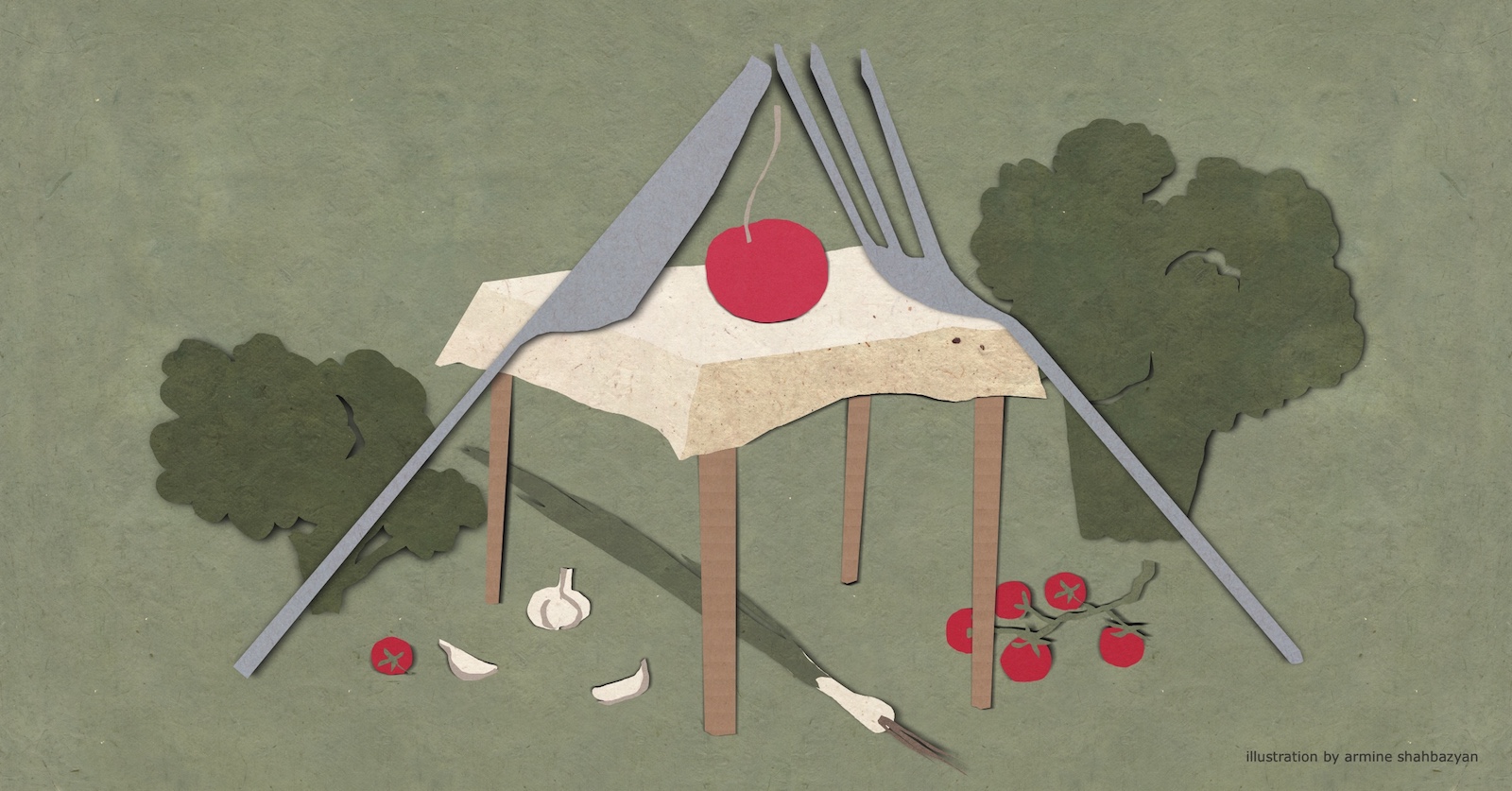
Listen to the article
In late 2022, Yerevan was alive with activity. Restaurants teemed with patrons every evening, making it a small feat to secure a table. Nikita Poderiagin, who began as a chef in his teenage years and later led Moscow’s acclaimed Bjorn restaurant, found himself drawn to Armenia in November that year after his other projects in Russia were put on hold. When they arrived, Poderiagin and his colleague, public relations agency owner Kristina Nechitaylenko, felt something that many other newcomers to Yerevan might recognize: a sense of possibility.
“Everything was booming,” Nechitaylenko recalls. “Everything was packed, and there were a lot of new places opening.” The city was buoyed by an inflow of Russians following Russia’s invasion of Ukraine. Motivated by Yerevan’s energy, the pair conceived Kuwa Izakaya, a unique take on a traditional Japanese izakaya. Their menu blended thoroughly Armenian ingredients with an international flavor—serving arishta in ramen, apricot in kimchi, and plating local sturgeon seasoned with the Japanese spice mix, togarashi. Poderiagin’s penchant for experimentation led him to tinker with a locally-produced sake, a first for Armenia.
Everything fell into place quickly. They found a commercial storefront on Teryan Street, partnered with local suppliers from around the country, and began operating in five months.
“When we opened, it was great in the beginning, the numbers were great,” Nechitaylenko says. And then came the shift. September marked Azerbaijan’s violent assault on Artsakh, which led to the ethnic cleansing of the Armenians and loss of the region. The instability, coupled with high costs of living and the inability to adapt eventually led to the decline of Yerevan’s migrant population from Russia.
This June, Kuwa Izakaya closed its doors after a year in operation. “Our concept, our expectations, everything was built on that time when restaurants were full 24/7,” Nechitaylenko says.
Their experience is not unusual. The past few years have ushered in a new era of dining in Yerevan—a city which had only 400 restaurants a little over a decade ago has more than triple that number today, according to one insider. Now, roughly 1,500 bars and restaurants are vying for the attention of just over a million residents, many of whom can no longer afford the luxury of regularly dining out. And some newcomers to the restaurant industry have seemingly built their businesses on sand, too dependent on a transient customer base of tourists and wealthy migrants who cannot sustain success in the long run. Just as the number of these businesses has boomed, so too has the rate of closures—hinting at a potential recalibration of the industry’s recent expansion, even as the country continues to achieve remarkable growth.
When a restaurant disappears, its absence is palpable. Walking past its former location often makes a closure more noticeable than other types of businesses. In Yerevan, that striking observation appears to be part of a trend. “The failure rate is high because business is tough,” says Ashot Barseghyan, a veteran of Armenia’s hospitality industry and director of the Restaurant Association NGO. In Barseghyan’s 14 years in the business, he has managed more than 20 eateries. When he first started, the failure rate for restaurants was around 10%, he says. Now, by his own calculations based on industry indicators, that risk has tripled. He estimates that 30% of new restaurants fail within six to 18 months of operation. For context, that failure rate is comparable to that of the United States. Though with a lack of official data from the Ministry of Economy, of which representatives were unable to provide data, the experiences of closures are largely anecdotal.
Barseghyan, and others in the restaurant business, cite the departure of Russians as one of the reasons for failure. Estimates of the Russian population in Yerevan vary significantly: about 100,000 came to Armenia in 2022, and now only a fraction remain, approximately 30,000-60,000—with many returning home, or seeking more affordable destinations. Barseghyan says the loss is felt acutely among business owners since Russians tend to spend more than other nationalities. “I would prefer one table of Russians,” he says, “than 30 Germans drinking one beer in half an hour.”
The huge number of people visiting and not residing in Armenia also seems to be abating. The federal Tourism Committee recorded 2.3 million tourists in 2023, a number which has somewhat softened by about 6% in the first half of this year. For those that do visit, they discover that the cost of a cappuccino rivals that of European countries, and that their spending power has diminished significantly since 2022. With a shrinking pool of diners, the city’s hospitality scene seems to have grown too much, too quickly.
Soaring rents and higher taxes are adding to the mounting difficulties. A director of a local bar with 17 years in Yerevan’s hospitality scene, who wished to remain anonymous, illustrates the problem: a bottle that once cost 8,000 AMD at wholesale now goes for 25,000 AMD because of tax hikes. “That’s a very, very big difference,” he says. “The margin was very different.” Factor in the additional costs of operating, like rents and licensing fees, and the strain is even more apparent—the annual cost of a license to operate after midnight recently quadrupled from 250,000 AMD to one million AMD. Added up, “these are not small amounts of money,” he says.
A goldilocks location—with good traffic, space, and light—is also becoming increasingly rare and costly to secure, especially given the concentration of hospitality businesses in the small center of Yerevan. Rents for commercial spaces vary wildly based on location, the availability of a terrace, and the owner’s discretion: some proprietors report paying just under $800 US per month, while others report seeing rents as high as $20,000 US per month. “The cost of location and rent is very disproportionate,” says Barseghyan, adding that rents have, in some cases, doubled twice in the space of two years. Some landlords play restaurant roulette with tenants, waiting for a contract to end before hiking up the rent for the next occupant. The variability in the price per square meter complicates comparisons with other cities, but each owner or manager who spoke to EVN Report reported the recent, dramatic rent increases.
Beyond the obvious financial strains, there are other reasons why a restaurant might fail. “There’s an urge to blame the business environment and in some cases that’s definitely true,” says Raffi Elliott, a contributor to EVN Report who recently closed his Quebec-inspired Poutinerie in Yerevan. But sometimes a concept is before its time, or failure has to do with its pricing, greed, or mismanagement. Others try too hard to fit in, he says, pointing to the Armenian “copycat culture” that has been amplified by the aesthetics of Instagram. New cafes and restaurants seem to replicate what they perceive to be a successful formula, but end up being indistinguishable from one another. “You see many restaurants which are looking the same, which offer the same thing, and are made by the same designers,” Barseghyan says, adding that there is no longer a clear reason for a customer to choose between these establishments. Others can’t seem to decide what they are at all. Desperate to get customer flow, it’s not uncommon to come across a menu listing pad thai, tabouli, pizza and even a hookah to boot. “They’re thinking, ‘What are people eating? Oh, pizza. Ok, let’s put it on the menu’,” says Elliott.
What about the establishments that do work? According to Barseghyan, the recipe for restaurant success boils down to prioritizing one key ingredient: “location first, location second, and location third.” And securing a spot on a prime street like Saryan—affectionately dubbed “Wine street”— is no longer a surefire path to success, he warns. “People think Saryan is fancy so any location will work, but no, there are no more good locations there,” Barseghyan says. “It needs to be sunny, there needs to be people passing, there needs to be a terrace, and a long facade.” He adds that in Yerevan, where locals favor outdoor seating for half the year, lacking a terrace could spell disaster for business.
He draws from his own experience of failure—attempting to open a franchise of an Italian cafe in Yerevan many years ago. He says the franchiser pushed to keep the Italian approach, such as drinking coffee at the bar on bar stools, which clashed with the local coffee culture, according to Barseghyan. “Armenians prefer cozy, and a little bit of luxury and comfort,” he says. Ultimately, the venture failed because of the mismatch.
One restaurant and bar owner who echoes this sentiment is Artak Harutyunyan, the proprietor of the newly-opened Black Angus Signature and The Collective—a trio of establishments including a cafe, a restaurant and a bar on Pushkin street. When asked about the secret to surviving in the industry, he responds: “In Armenia? To be honest, not food.” Locals search for a good atmosphere and a comfortable place, he says. “Food is important of course,” he adds, “but it’s all about the small things, like the outside veranda, the service, the design, the chairs, the plants” and specifically, he says, warm 2700 Kelvin lights.
Despite the challenges, there are many who emphasize the strengths of Yerevan’s evolving restaurant industry. Grigory Hakobyan, of the Association of Restaurateurs and Hoteliers of Armenia, says gastronomic tourism has increased, as well as the number of young, local chefs willing to experiment. “Armenia’s hospitality sector is actively developing, new establishments are emerging, and the level of service is constantly improving,” he wrote to EVN Report. “In my opinion, the potential change due to the departure of migrants is likely to be borne only by individual projects that exclusively targeted that segment as a consumer.” He adds that the sector is still developing steadily, presenting ample opportunities to create unique and memorable experiences for patrons.
Entrepreneurs like chef Poderiagin and Nechitaylenko agree. They still see promise in Yerevan’s evolving restaurant scene, even though their initial success was short-lived. “When you fail, you learn,” says Nechitaylenko. “That’s the most valuable experience you have because it teaches you what you need to do differently.”
Also see
Greenhouses: Easy to Buy, Difficult to Manage
Although some regions of Armenia have the necessary conditions for greenhouse farming, few dare to invest in them. Anahit Harutyunyan looks at the risks and challenges.
Read moreArmenian Wine Traditions Rediscovered
The 2007 discovery of a 6,000-year-old winery in a cave in the Vayots Dzor region was an invitation for Armenians to rediscover their ancient wine-making traditions. Armenia’s once-forgotten wine culture began to reemerge and take on new forms.
Read moreInterrupted Flavors: Thoughts on Armenian Cuisine
Attitudes toward food and culinary art can reveal much about a people’s past and future. Ella Kanagerian writes that we are trying to work with our cultural influences and approach the concept of national cuisine more consciously.
Read more









As confessed by the proprietor, food is not a priority when visiting a restaurant in Armenia, but everything else is. Wanting to be seen at a particular restaurant is more important than what is served. This is nothing short of a disaster in the making for the important sector of the economy, tourism. When the food quality and variety is nowhere comparable to what you can get in any European capital but the price is, a non Armenian visitor or a cost conscious Armenian visitor will think twice before booking a vacation in Armenia. Short term gains are practically part of Armenian DNA. Yes, there is inflation in Armenia post pandemic like everywhere else, but price gauging is too obvious when visiting specially tourist centered restaurants in Yerevan.
Many people don’t realize how complicated and exhausting the restaurant business is. Often, people open restaurants without considering the most important question: why are they doing it? For me, “making money” was never the right answer. One can make much more money in another business with the same effort and investment.
Yerevan has been trying to become a restaurant city for a long time, but it hasn’t succeeded yet. We have very few establishments that resonate with locals while standing out due to their unique concepts and character.
There are very few “foodies” and “gourmets” in Yerevan, and even fewer in other cities. Foreign restaurateurs who opened and failed in Yerevan didn’t understand this.
One reason the restaurant industry is developing slowly is due to clueless laws governing it. Another self-inflicted reason is that new owners often spend half a year on extensive remodeling, only to burn out and close after a short time. During this short time, they attract guests from the already limited pool of restaurant-goers. Then another restaurant opens, makes a big splash, attracts the same guests, and eventually fails. This cycle repeats over and over.
As the co-founder of The Club (2004), In Vino (2012), Tapastan (2014), Steakarar (2022), and 6100 (2024), I can attest that the rules haven’t changed. Aside from the oligarch-owned restaurants, the survivors are those who have a loyal customer base, have been around for a while and know how to navigate tough times, believe in a certain idea and have the financial means to support it.
As for failures, there are too many reasons to list here.